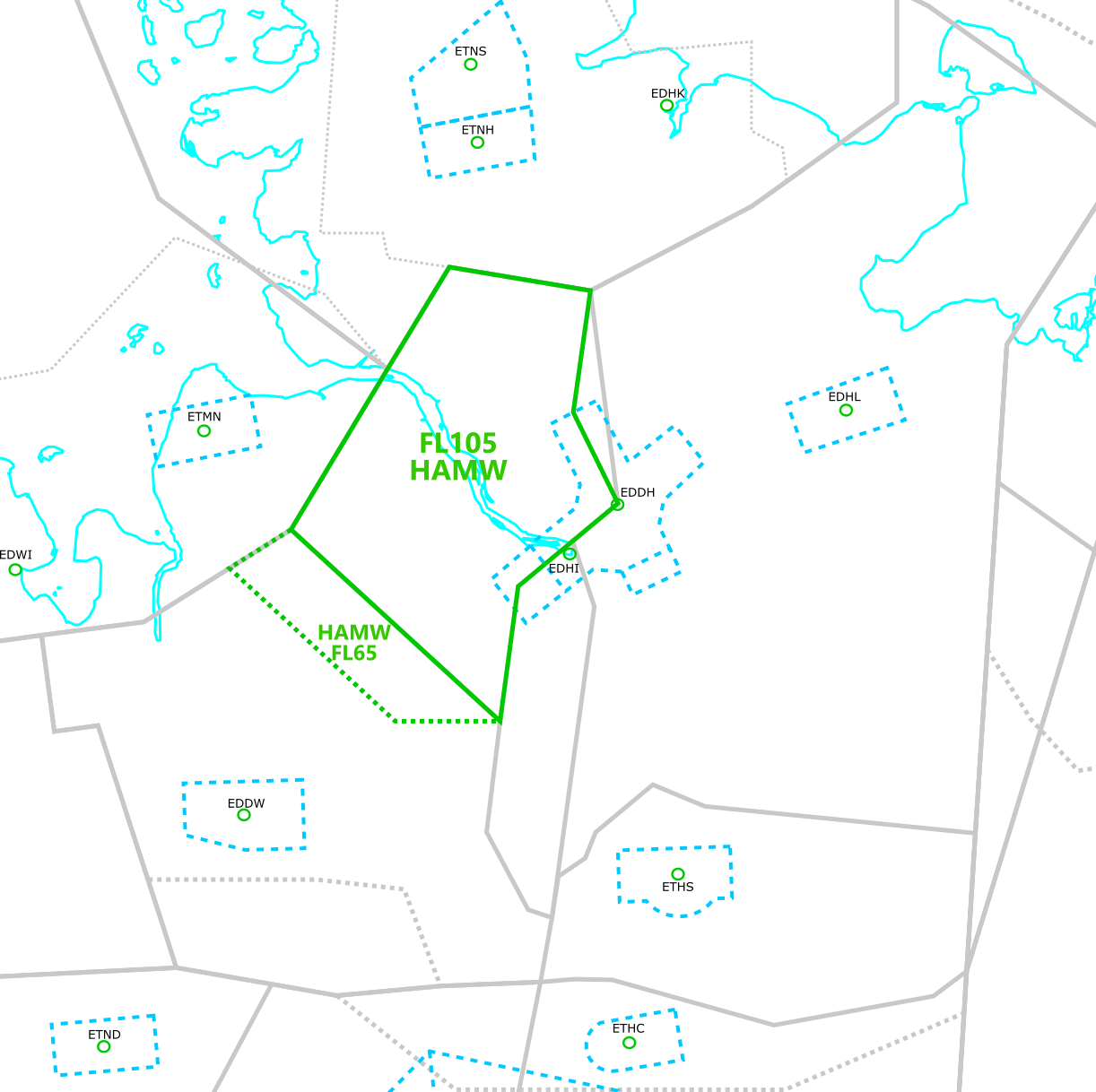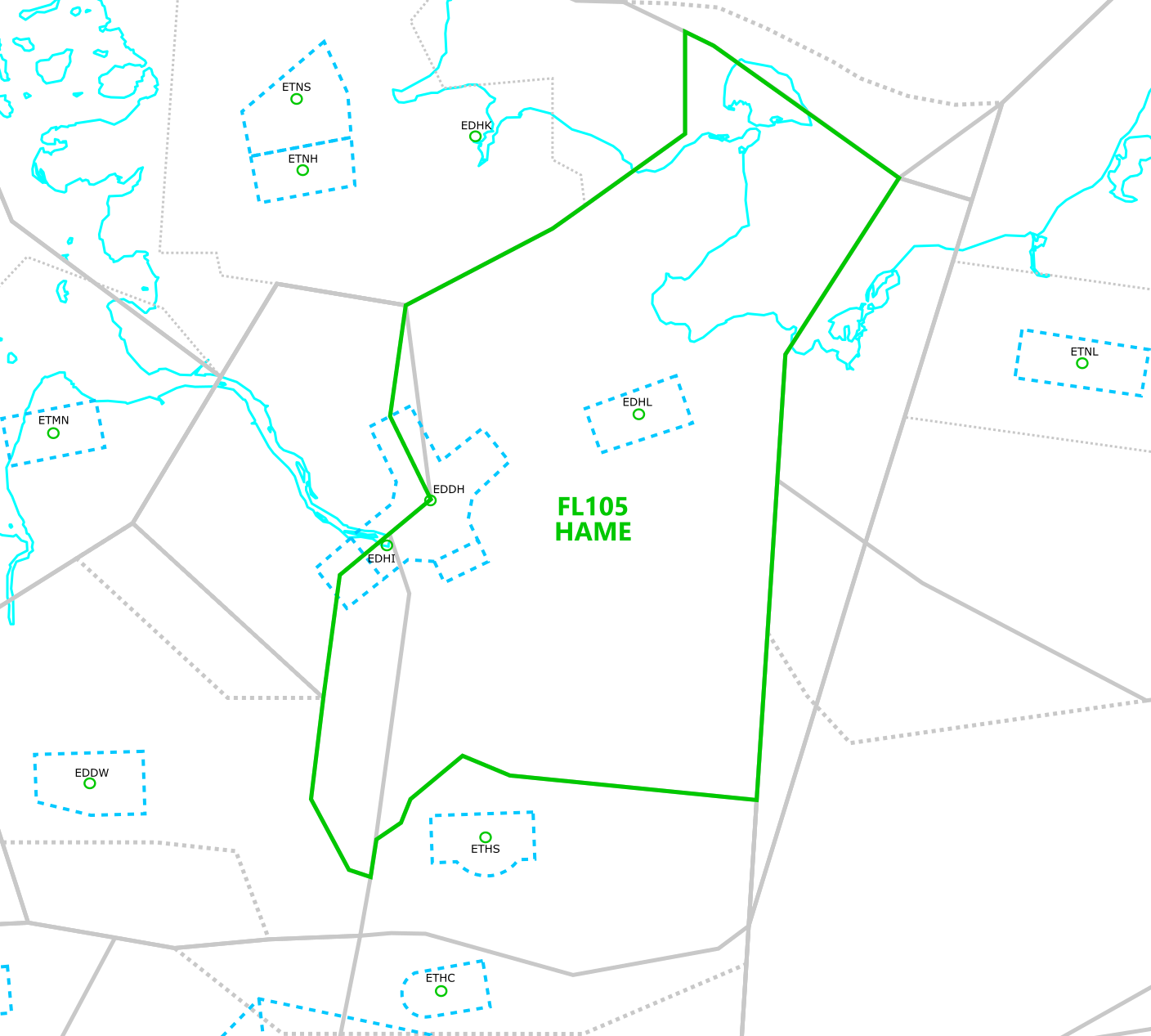Arrival
Area of Responsibility: The Hamburg Arrival airspace reaches up to FL105 and covers Hamburg Fuhlsbüttel (EDDH), Hamburg Finkenwerder (EDHI) and Lübeck Blankensee (EDHL). To the west of the Elbe river, the AoR is divided. The lower part up to FL65 belongs to the Friesland Sector (EDDW_APP), between FL65 and FL105, HAMW is responsible.
The airports Lübeck Blankensee (EDHL) and Hamburg Finkenwerder (EDHI) are covered by HAME in the absence of a tower.
Hamburg Finkenwerder (EDHI) can be delegated to EDDH_TWR.
 |
 |
Airspace: The inner ring of airspace C starts at 2500 feet MSL and ends at FL100. Additional rings are similarly dimensioned and start at 3500/4500/5500ft MSL or FL75 respectively. In order to keep arriving IFR traffic inside protected airspace, a TMZ located north of NOLGO between FL60/FL75 and FL100 has been set up.
Airspace D (HX) west of Finkenwerder may only be activated, if RWY 05 is in use at Hamburg-Finkenwerder.

Charlie + TMZ Airspace of Hamburg and Lübeck - © openflightmaps.org
Minimum Vector Altitude: The minimum vector altitude can be displayed in the DFS Pack with Alt + M.
Arrivals
According to SOP, all arriving aircraft are cleared for a STAR by Center.
Normal Procedures: During normal and low-traffic operation, radar vectors are used for arriving traffic before reaching the IAF.
Early directs to DH/HI/HL waypoints in coordination with adjacent sectors are to be used.
High traffic operation: With increasing traffic density, it is typically common to refrain from using direct routes and instead utilize published procedures (STARs). It is important to ensure that arriving traffic descends in a timely manner to separate it from departures.
Very high traffic operation: If an extremely high traffic density leads to the inability to maintain the target spacing, the center sectors are to be informed immediately. See Holding section
Hamburg Finkenwerder Arrivals:
Da Flüge zu den Flughäfen Lübeck (EDHL) und Hamburg-Finkenwerder (EDHI) betreut werden, sollte man mit den dortigen Verfahren vertraut sein. Für Finkenwerder stehen keine STARs zur Verfügung, anstelle können RNAV Verfahren von den Ausgangspunkten der STARs für EDDH (RIBSO/BOGMU/RARUP/NOLGO) freigegeben werden. Diese Verfahren enden am IF HI256 beziehungsweise HI035. An- und Abflüge nach/von Finkenwerder haben ein erhöhtes Konfliktpotential mit EDDH-Verfahren. Bei bestimmten Pistenkonfigurationen muss sicherheitsbedingt ein Abflugstopp für EDDH verhängt werden. Eine Koordination mit Hamburg Turm sollte in allen Fällen erfolgen, da spätestens ein Fehlanflug problematisch werden könnte. Alle Flüge von/nach Hamburg und Finkenwerder sind nach Möglichkeit im sicheren Luftraum (TMZ/D/C) zu halten. In Lübeck findet das Verfahren aufgrund der Luftraumstruktur keine Anwendung.
Zielseparation
Grundsätzlich sind diese Werte als Minima zu verstehen und sollen auf Anfrage eines Towers für VFR-Verkehr erweitert werden. Die Abstände sind so gewählt, dass die Lücken für Depatures ausreichend groß sind. Geringere Staffelungswerte können jederzeit koordiniert werden.
Die Wirbelschleppenstaffelung ist einzuhalten!
| DEP |
ARR |
Separation (nm) |
| 33 |
23 |
3 |
| 33 |
05 |
5 |
| 23 |
15 |
5 |
| 05 |
15 |
5 |
| 05 |
05 |
6 |
| 15 |
15 |
6 |
| 23 |
23 |
6 |
| 33 |
33 |
6 |
Sektorübersichten
Der Hamburg West darf nur besetzt werden, wenn der Director online ist. Eine Zuordnung die nicht den Sektorgrenzen entspricht, sondern den Gegenanflügen der STAR entspricht kann für eine gerechtere und sinnvollere Arbeitsverteilung sinnvoll sein.
